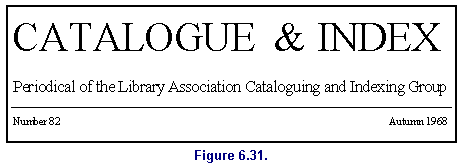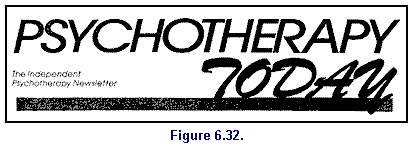Cataloger's Reference Shelf
CONSER Cataloging Manual
6.3. Other title information
If a word or phrase is not included in the title proper, consider if such a word or phrase constitutes other title information, and if it does, whether it should be transcribed in the title statement as instructed in AACR2 12.1E1.
AACR2 defines other title information as:
A title borne by an item other than the title proper or parallel or series title(s); also any phrase appearing in conjunction with the title proper, etc., indicative of the character, contents, etc. of the item or the motives for, or occasion of, its production or publication. The term includes subtitles, avant-titres, etc., but does not include variations on the title proper (e.g., spine titles, sleeve titles).
As can be seen from the definition, the term "other title information" is broad and includes the traditional "subtitle" as well as other types of title phrases found on the piece or supplied by the cataloger.
With the exception of supplied data, record other title information only from the chief source (AACR2 1.1E1). Statements that would normally constitute other title information that are found only on other sources may be given in a note.
The concept of "other title information" was introduced in AACR2. Under earlier rules, subtitles were sometimes given in quoted notes (field 500 ) and sometimes in the title statement ( 245 $b). When AACR2 was first implemented, CONSER adopted an "augmented level one" description for serials which prohibited the recording of other title information, except in certain circumstances. The prohibition sought to keep extraneous information from cluttering the title statement, particularly because this information is likely to change. Subsequently, the restriction was loosened to enable recording of other title information that was considered useful for the identification of the serial. With the revision of Chapter 12 in 2002, the rule reflects the situations in which other title must be given and allows the cataloger to decide what to do in other cases.
6.3.3. Other title information that must be transcribed
There are three situations in which the cataloger must transcribe the other title information:
When an acronym or initialism appears on the chief source with the full form, the full form is transcribed as the title proper (AACR2 12.1B2) and the acronym or initialism is given as other title information (AACR2 12.1E1; see also CCM 6.1.4.d.).
|
|
In Figure 6.30., the full form is the title proper and the initialism is given as other title information.
245 00 $a Health services research : $b HSR. 246 30 $a HSR |
b. The statement of responsibility is embedded in the other title information
245 00 $a Ellinokos horos and traditions : $b a newsletter of the Greek International Folk Dance Federation.
245 00 $a Espacio y desarrollo : $b boletin del C.I.G.A.
245 00 $a Field notes : $b newsletter of the Arkansas Archeological Society.

245 00 $a Catalogue & index : $b periodical of the Library Association Cataloguing and Indexing Group.
c. Other title information that is supplied by the cataloger
When the title consists only of the name of a person or corporate body alone, supply a brief subtitle, such as "[report]", "[proceedings]", etc. according to AACR2 1.1E6. Give the supplied title in the language of the title proper and take it from the piece (e.g., the preface) when possible to best identify the serial. By supplying wording that is found in the serial itself, the nature of the serial is more likely to be reflected accurately and recording this wording allows other catalogers to be sure that the record is for the serial. (See also CCM 6.1.8. and Fig. 6.27.)
6.3.4. Other title information that may be transcribed in the title statement, given as a note, or omitted
The most common type of other title information found is the subtitle, which is described by the second type given in the definition: "any phrase appearing in conjunction with the title proper, etc., indicative of the character, contents, etc. of the item ..." While AACR2 does not define a subtitle, the term is defined in the ALA Glossary as:
The explanatory part of the title following the main title.
Examples:
Montana
The magazine of Western history
Chronicles
A magazine of American culture
Food production management
The publication on growing, processing, packaging, distribution
Linguistics
A monthly review
Use judgment when considering whether to include other title information in the record. The reason that it was not generally given prior to AACR2 and that its use has been restricted more recently is that it is the type of information that tends to be unstable and likely to change.

In Figure 6.32., the phrase "The independent psychotherapy newsletter" adds little to the title and has been omitted.
245 00 $a Psychotherapy today.
Additional examples:
On piece:
Monoclonal antibodies: a quarterly publication containing availability of new monoclonal antibodies for all researchers.
In record:
245 00 $a Monoclonal antibodies.
On piece:
Linguistics: a monthly review
In record:
245 00 $a Linguistics.
There are times, however, when other title information can be very useful in helping to identify a serial with a title that is not very explanatory. In such cases, consider how the title will display or file in the catalog and whether it is preferable to record the information in a quoted note (500) or within the title statement. The decision is up to the cataloger.
245 00 $a Montana : $b the magazine of Western history.
245 00 $a Computers and libraries : $b an Australian directory.
245 00 $a Dialogue.
500 ## $a "A journal of Mormon thought."
245 0# $a Camera obscura.
500 ## $a "A journal of feminism and film theory."
b. Titles other than the title proper
The first sentence in the definition (see CCM 6.3.1.) describes "a title borne by the item other than the title proper" as also being other title information. This type of other title information may be thought of as the equivalent of an " alternative title" without the preceding word "or." In such cases, both titles are independent of each other and either one might be chosen as the title proper. Neither explains the other. (See also CCM 6.1.4.b. and Figure 6.11.).
Titles on piece:
Super television
Camcorder report
In record:
245 00 $a Super television : $b camcorder report.
246 30 $a Camcorder report
|
In Figure 6.33., either title could stand alone as the title of the serial.
245 00 $a Teddy Bear artist's annual : $b who's who in bear making. 246 30 $a Who's who in bear making |
|
Summary: other title information
Always record in the title statement:
![]() Acronym or initialism when full form has been recorded as title proper
Acronym or initialism when full form has been recorded as title proper
![]() Other title information that contains the statement of responsibility
Other title information that contains the statement of responsibility
![]() Other title information that is supplied per AACR2 1.1E6
Other title information that is supplied per AACR2 1.1E6
Do not generally record:
![]() Subtitles that do not contain the statement of responsibility and add little to the understanding of the title
Subtitles that do not contain the statement of responsibility and add little to the understanding of the title
Consider recording in title statement or as a note:
![]() Subtitles that indicate the nature of the title when the title proper does not
Subtitles that indicate the nature of the title when the title proper does not
![]() Titles other than the title proper
Titles other than the title proper
6.3.5. When to give access to other title information (field 246 )
Give access to other title information through the form of an added entry in the following situations:
a. Give an added entry for:
![]() an acronym or initialism that has been recorded as other title information
an acronym or initialism that has been recorded as other title information
![]() titles other than the title proper
titles other than the title proper
b. Do not usually give an added entry for:
![]() a subtitle
a subtitle
![]() other title information that has been supplied
other title information that has been supplied
See also: